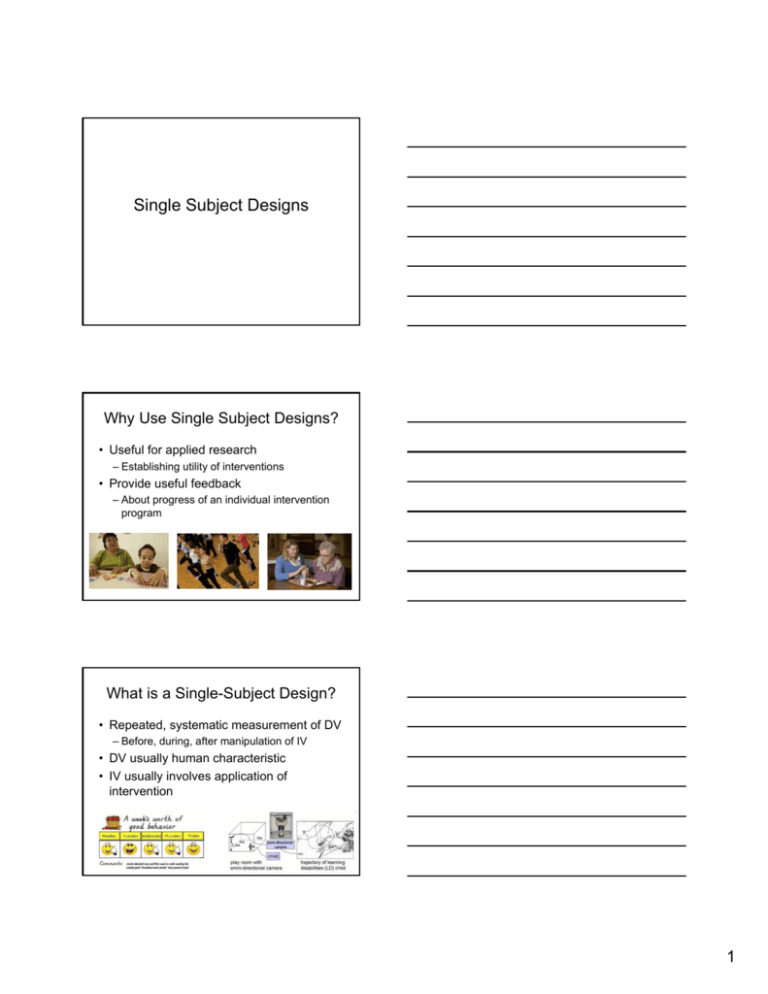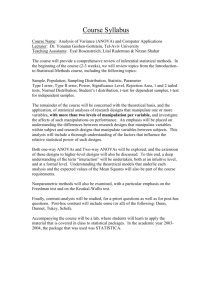Single Subject Designs
advertisement

Single Subject Designs Why Use Single Subject Designs? • Useful for applied research – Establishing utility of interventions • Provide useful feedback – About progress of an individual intervention program What is a Single-Subject Design? • Repeated, systematic measurement of DV – Before, during, after manipulation of IV • DV usually human characteristic • IV usually involves application of intervention 1 Characteristics of SSD • Repeated observation – Same behavior measured repeatedly – Determines consistency over time – Serves as a control for variability • Consistent observation technique – Conditions for data collection • Standardized • Trained observers – Allows meaningful comparisons over time Characteristics of SSD • Description of conditions – Clear and detailed – Strengthens internal & external validity • Baseline and treatment conditions – Baseline • Target behavior (DV) observed & recorded • No intervention/treatment (IV) – Treatment • Experimental manipulation (IV) is introduced • Target behavior (DV) observed & recorded – Long enough to achieve stability in DV Manipulation During Treatment • Operant – Behavior that operates on environment – Response that will be strengthened/weakened • Reinforcement – Increases behavior • Punishment – Decreases behavior 2 Manipulation During Treatment • Operationally define behavior and treatment • Determine behavioral baseline (A) – Measure and record behavior repeatedly • Introduce treatment (B) – Measure and record behavior repeatedly • Remove treatment (A) – Measure and record behavior repeatedly Observation and Manipulation Phases • Length – Until behavior is stable and consistent • Changing phase – Treatments introduced, withdrawn or changed • Measuring the response – Most common: rate of response • Total frequency of response • Time response occurs Measuring Response Cumulative Record of Response Graphing Data in Single Subjects Designs 3 Types of Single-Subject Designs • Withdrawal Designs A- B A–B–A A–B–A–B • Multiple-Baseline Designs • Alternating-Treatments Designs • Changing-Criterion Designs A-B Withdrawal Design • Used to quickly assess the effects of a treatment – Phase 1 (A) • Measure baseline response – Phase 2 (B) • Introduce treatment while measuring response • Disadvantage – Inability to distinguish experimental effect from confounds Example of A-B Design • Bob has a habit of cursing at work – Co - workers complain • Treatment – Pay $5 • “Session” = Work day 4 Example of A-B Design Baseline Treatment 16 Number of curse words (DV) 14 12 10 8 6 4 2 0 1 2 3 4 5 6 7 8 9 10 11 12 13 14 15 16 17 Sessions (time) A-B-A Withdrawal Designs • Simplest of single subject designs • Repeatedly introduces and withdraws treatment – Baseline phase (A) – Treatment phase (B) – Withdrawal phase (A) Example of A-B-A Design • Cat loves to play with the family dog • Dog not tolerant of cat – Captures cat between teeth – Painful to cat • Change dog’s behavior – Use behavior modification 5 Example of A-B-A Design • Instituted sophisticated verbal treatment – The “NO!- - NO!—BAD DOG!” treatment • Week 1: Recorded number of times dog bit cat • Week 2: Every time dog bit cat, instituted treatment while continuing to record behavior • Week 3: Record behavior without treatment Example of A-B-A Design A-B-A Advantages and Disadvantages • Advantage – Withdrawal phase • Allows more reliable assessment of intervention effects • Confounds – Unlikely to co-occur repeatedly with treatment • Disadvantage – Can’t use with irreversible treatment effects – Ethical concerns with withdrawing treatment – Use A - B - -A Bdesigns 6 Example of A-B-A-B Design • Taylor (4 yrs old) – Partial leg paralysis – Lacks upper body strength • Goal – Increase strength and endurance • Target behavior – Ambulate 10 consecutive lengths of parallel bars – No rest breaks – 3 consecutive days • Treatment – Wheelchair pushups – Bar graph monitoring of progress Example of A-B-A-B Design Multiple Baseline Designs • Evaluation across individuals, settings, or behaviors • Useful for evaluating interventions – Likely to cause enduring change in DV • Withdrawal designs – Use withdrawal phase to control threats to internal validity • Multiple baseline designs – Control by varying length of the baseline 7 Example 1a of Multiple Baseline Project 1 • Intervention – Enhancing quality of life in public housing • Intervention – Community organization Project 2 • Behavior – Time to repair apartments Project 3 Example 1b of Multiple Baseline Project 1 • Threats to internal validity – Controlled by multiple baselines – 3rd variable problem Project 2 • Show up on all charts simultaneously • Causal inferences – Depend on independent observations across charts Project 3 Example 1b of Multiple Baseline Project 1 • Explanation for changes across charts 1. Third variable causes change 2. Intervention B causes change • Observations are not independent Project 2 Project 3 8 Alternating Treatment Designs • Useful for evaluating effect of several treatments – Same individual • Different treatments – Alternated several times – Order randomly determined or counterbalanced • Each treatment replicated – Each time introduced Alternating Treatment Designs • After baseline – Treatments administered • Alternating – Instructions before each treatment • Possible confounds – Counterbalanced during experiment • Data plotted separately – For each intervention Example of Alternating Treatment Design • Treatment A – Social reinforcement for cooperating – Ignoring uncooperative behavior • Treatment B – Social reinforcement for cooperating – Time out for uncooperative • Treatments alternated during day – Morning session – Afternoon session 9 Changing Criterion Design • Variation of multiple-baseline design • Useful for incrementally changing target behavior – Criteria for target behavior set – When criteria met • Set new criteria • Each phase provides baseline for subsequent phases Example of Changing Criterion Design • DV = # math problems solved correctly • Baseline worksheet with 9 division problems • Criteria set at 2 correct problems solved • Increased +1 – 3 consecutive days criteria met External Validity Issues • Single subject designs criticized – Issues related to external validity • Behavior analysts – Concerned with establishing robustness of a few variables • Reinforcement • Stimulus control – Not concerned about individual differences • Direct, systematic replication is important 10 Benefits of Single Subject Design • Rigorous methodology – Identify functional variables. • See pattern of action of DV • Make informed statements about: – Acquisition – Maintenance – Generalization Benefits of Single Subject Design • Study low incidence populations and behaviors • Cost effective – Evaluate intervention prior to large scale study • Flexible design is adaptable to situation • Can be conducted in practice settings – Test clinical hypotheses – Monitor progress in applied settings Limitations of Single Subject Design • Does not answer questions related to external validity very well – Not intended for those types of questions • Data analysis via visual inspection of data – Can result in unreliable interpretation – No established standards – Low agreement among observers 11 Limitations of Single Subject Design • Aggregating results across studies – No established methods – Meta - analysis may be useful • Important for validating interventions as “evidencebased” • Practitioners do not have time/access to primary source material • Standards for validating interventions as evidence-based – Just emerging • No consensus among standards In Class Exercise ABA Design • Break into groups of 4 – 6 students – Each student pairs up with another student – Decide who will record behavior and who engage in behavior • Hypothesis: Exercise increases pulse rate • Treatment = exercise – Operationally define “exercise” • Behavior = pulse rate – Heart beats per minute • (# beats in 30 seconds) X 2 • Define exercise – note on sheet – Measure & record behavior in 1 minute intervals – Baseline, treatment, withdrawal – Complete graph for each student engaging in behavior 12







